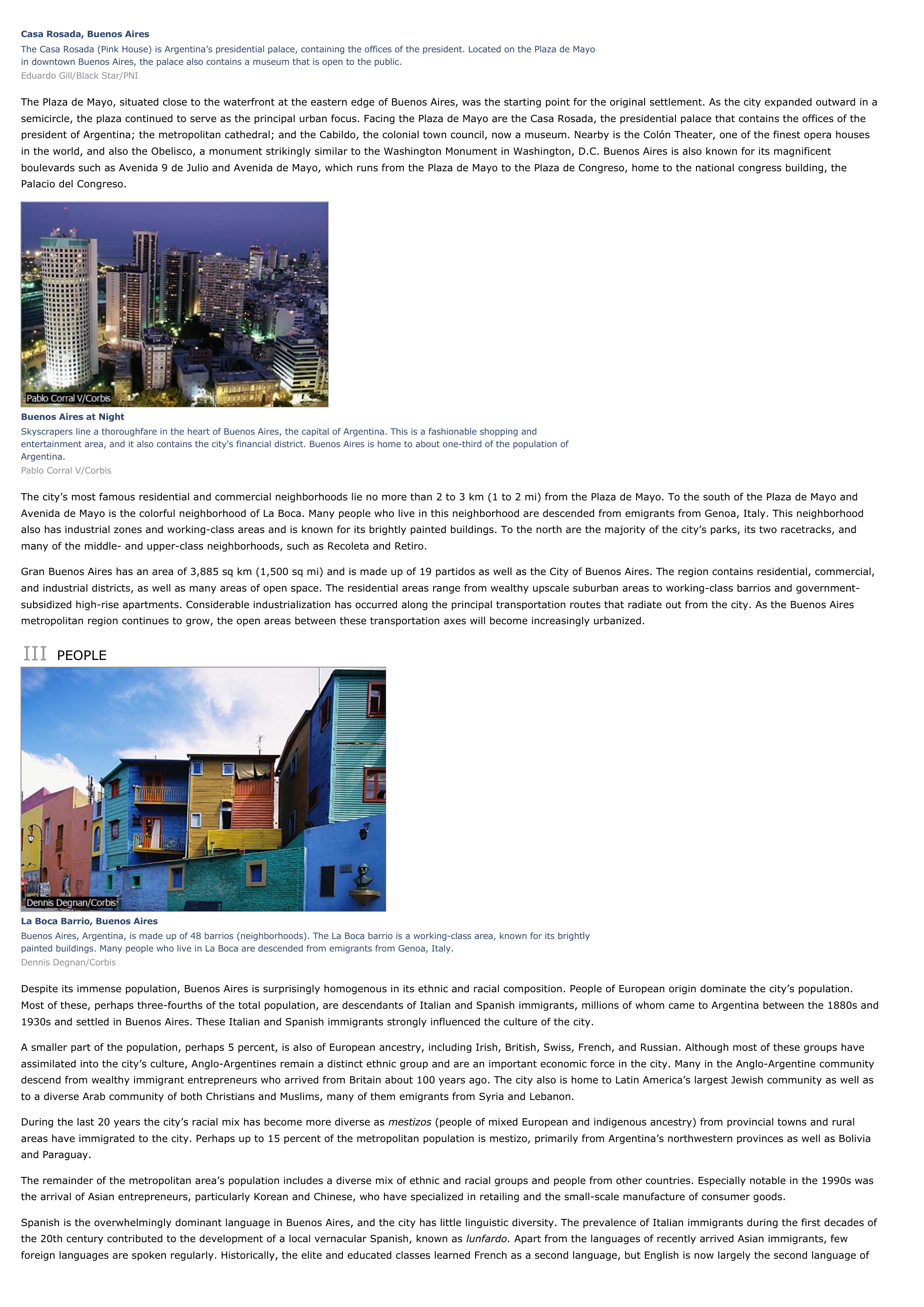Buenos Aires (city) - geography.
Publié le 27/05/2013

Extrait du document
«
Casa Rosada, Buenos AiresThe Casa Rosada (Pink House) is Argentina’s presidential palace, containing the offices of the president.
Located on the Plaza de Mayoin downtown Buenos Aires, the palace also contains a museum that is open to the public.Eduardo Gill/Black Star/PNI
The Plaza de Mayo, situated close to the waterfront at the eastern edge of Buenos Aires, was the starting point for the original settlement.
As the city expanded outward in asemicircle, the plaza continued to serve as the principal urban focus.
Facing the Plaza de Mayo are the Casa Rosada, the presidential palace that contains the offices of thepresident of Argentina; the metropolitan cathedral; and the Cabildo, the colonial town council, now a museum.
Nearby is the Colón Theater, one of the finest opera housesin the world, and also the Obelisco, a monument strikingly similar to the Washington Monument in Washington, D.C.
Buenos Aires is also known for its magnificentboulevards such as Avenida 9 de Julio and Avenida de Mayo, which runs from the Plaza de Mayo to the Plaza de Congreso, home to the national congress building, thePalacio del Congreso.
Buenos Aires at NightSkyscrapers line a thoroughfare in the heart of Buenos Aires, the capital of Argentina.
This is a fashionable shopping andentertainment area, and it also contains the city's financial district.
Buenos Aires is home to about one-third of the population ofArgentina.Pablo Corral V/Corbis
The city’s most famous residential and commercial neighborhoods lie no more than 2 to 3 km (1 to 2 mi) from the Plaza de Mayo.
To the south of the Plaza de Mayo andAvenida de Mayo is the colorful neighborhood of La Boca.
Many people who live in this neighborhood are descended from emigrants from Genoa, Italy.
This neighborhoodalso has industrial zones and working-class areas and is known for its brightly painted buildings.
To the north are the majority of the city’s parks, its two racetracks, andmany of the middle- and upper-class neighborhoods, such as Recoleta and Retiro.
Gran Buenos Aires has an area of 3,885 sq km (1,500 sq mi) and is made up of 19 partidos as well as the City of Buenos Aires.
The region contains residential, commercial,and industrial districts, as well as many areas of open space.
The residential areas range from wealthy upscale suburban areas to working-class barrios and government-subsidized high-rise apartments.
Considerable industrialization has occurred along the principal transportation routes that radiate out from the city.
As the Buenos Airesmetropolitan region continues to grow, the open areas between these transportation axes will become increasingly urbanized.
III PEOPLE
La Boca Barrio, Buenos AiresBuenos Aires, Argentina, is made up of 48 barrios (neighborhoods).
The La Boca barrio is a working-class area, known for its brightlypainted buildings.
Many people who live in La Boca are descended from emigrants from Genoa, Italy.Dennis Degnan/Corbis
Despite its immense population, Buenos Aires is surprisingly homogenous in its ethnic and racial composition.
People of European origin dominate the city’s population.Most of these, perhaps three-fourths of the total population, are descendants of Italian and Spanish immigrants, millions of whom came to Argentina between the 1880s and1930s and settled in Buenos Aires.
These Italian and Spanish immigrants strongly influenced the culture of the city.
A smaller part of the population, perhaps 5 percent, is also of European ancestry, including Irish, British, Swiss, French, and Russian.
Although most of these groups haveassimilated into the city’s culture, Anglo-Argentines remain a distinct ethnic group and are an important economic force in the city.
Many in the Anglo-Argentine communitydescend from wealthy immigrant entrepreneurs who arrived from Britain about 100 years ago.
The city also is home to Latin America’s largest Jewish community as well asto a diverse Arab community of both Christians and Muslims, many of them emigrants from Syria and Lebanon.
During the last 20 years the city’s racial mix has become more diverse as mestizos (people of mixed European and indigenous ancestry) from provincial towns and rural areas have immigrated to the city.
Perhaps up to 15 percent of the metropolitan population is mestizo, primarily from Argentina’s northwestern provinces as well as Boliviaand Paraguay.
The remainder of the metropolitan area’s population includes a diverse mix of ethnic and racial groups and people from other countries.
Especially notable in the 1990s wasthe arrival of Asian entrepreneurs, particularly Korean and Chinese, who have specialized in retailing and the small-scale manufacture of consumer goods.
Spanish is the overwhelmingly dominant language in Buenos Aires, and the city has little linguistic diversity.
The prevalence of Italian immigrants during the first decades ofthe 20th century contributed to the development of a local vernacular Spanish, known as lunfardo. Apart from the languages of recently arrived Asian immigrants, few foreign languages are spoken regularly.
Historically, the elite and educated classes learned French as a second language, but English is now largely the second language of.
»
↓↓↓ APERÇU DU DOCUMENT ↓↓↓
Liens utiles
- Buenos Aires (city) - geography.
- Torre Nilsson Leopoldo, 1924-1978, né à Buenos Aires, cinéaste argentin.
- Solanas Fernando Ezequiel, né en 1936 à Buenos Aires, cinéaste argentin.
- Savary Jérôme , né en 1942 à Buenos Aires, homme de théâtre français.
- Plata (La), ville d'Argentine, capitale de l'État de Buenos Aires.

































